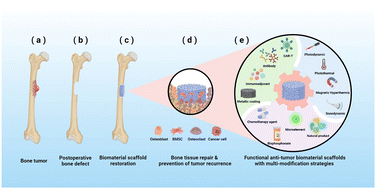Functional anti-bone tumor biomaterial scaffold: construction and application
Abstract
Bone tumors, including primary bone tumors and bone metastases, have been plagued by poor prognosis for decades. Although most tumor tissue is removed, clinicians are still confronted with the dilemma of eliminating residual cancer cells and regenerating defective bone tissue after surgery. Therefore, functional biomaterial scaffolds are considered to be the ideal candidates to bridge defective tissues and restrain cancer recurrence. Through functionalized structural modifications or coupled therapeutic agents, they provide sufficient mechanical strength and osteoinductive effects while eliminating cancer cells. Numerous novel approaches such as photodynamic, photothermal, drug-conjugated, and immune adjuvant-assisted therapies have exhibited remarkable efficacy against tumors while exhibiting low immunogenicity. This review summarizes the progress of research on biomaterial scaffolds based on different functionalization strategies in bone tumors. We also discuss the feasibility and advantages of the combined application of multiple functionalization strategies. Finally, potential obstacles to the clinical translation of anti-tumor bone bioscaffolds are highlighted. This review will provide valuable references for future advanced biomaterial scaffold design and clinical bone tumor therapy.

- This article is part of the themed collections: Journal of Materials Chemistry B Recent Review Articles and #MyFirstJMCB


 Please wait while we load your content...
Please wait while we load your content...